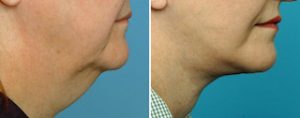The facelift is one of the most recognized surgeries for facial aging. Patients ranging from their forties until the late eighties receive substantial benefits from a variety of facelift techniques. Cleaning up loose skin and fat from the neck and jowls and re-creating a youthful jawline is the objective of any facelift procedure and it is highly successful in doing so. Most every plastic surgeon has great examples of some dramatic before and after surgery examples demonstrating the powerful effects of the procedure.

For some patients, they comment on the lack of the dramatic improvement they expected around the mouth or central neck or that there has been some skin laxity in these areas that has reappeared. This reappearance of skin rolls is known as rebound relaxation and is reflective of the viscoelastic properties of skin, it can be stretched out but there will be some recoil back. Some people interpret this as a ‘failed’ facelift that has not lasted but this is not true. It is reflective in many cases of the degree of aging problem and/or the natural properties of the patient’s skin.
Because of some rebound relaxation, patients should be aware that they may need a secondary facelift or tuck-up within a year or two after their procedure to either achieve the best result or to re-establish the more complete initial result that they saw. Addressing the need for secondary facelifts in the December issue of Plastic and Reconstructive Surgery was an article entitled ‘The Staged Facelift: Addressing the Biomechanical Limitations of the Primary Rhytidectomy’. Employing the definition of most plastic surgeons (not patients), a successful facelift is a result that makes the patient appear up to 10 years younger and lasts as least two years. Therefore, any form of a tuck-up done within two years would be called a secondary facelift. (I prefer to call it a secondary tuck-up) In this paper, the authors looked at a series of nearly 750 patients who had undergone a facelift and looked at how many secondary facelifts were done.
How many patients in this paper underwent a secondary facelift? Nearly fifty patients or 6% of the study series had them. The need for the secondary procedure were early symptoms of skin looseness around the mouth and central neck or incomplete correction of the neck angle the first time around. High rates of patient satisfaction occurred with these secondary procedures.
The take home message is that not all facelifts do an even or complete job of rejuvenating the face and neck or lasts forever. Just because some recurrent skin laxity occurs in the first months to years after the procedure does not make the facelift a failure or is reflective of a plastic surgeon’s ability. Some patients will benefit from an additional procedure which is usually far less in scope than the original facelift. Prospective facelift patients should be aware of this possibility before ever having surgery as this potential need is not rare.
Dr. Barry Eppley
Indianapolis, Indiana


